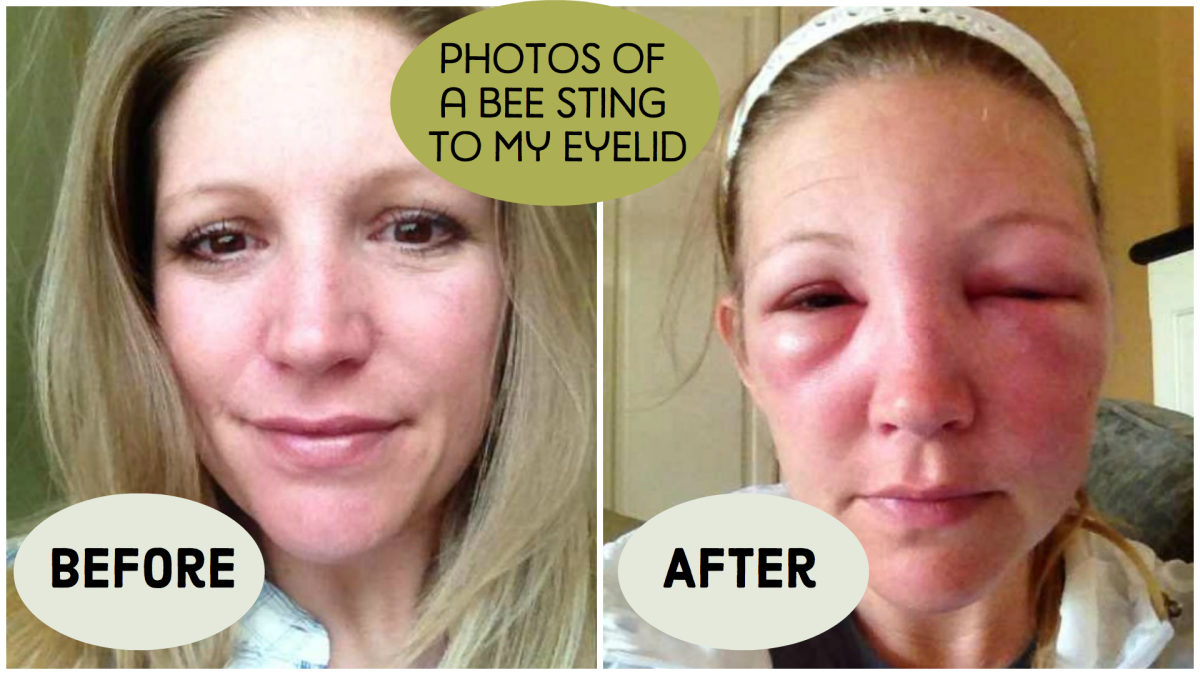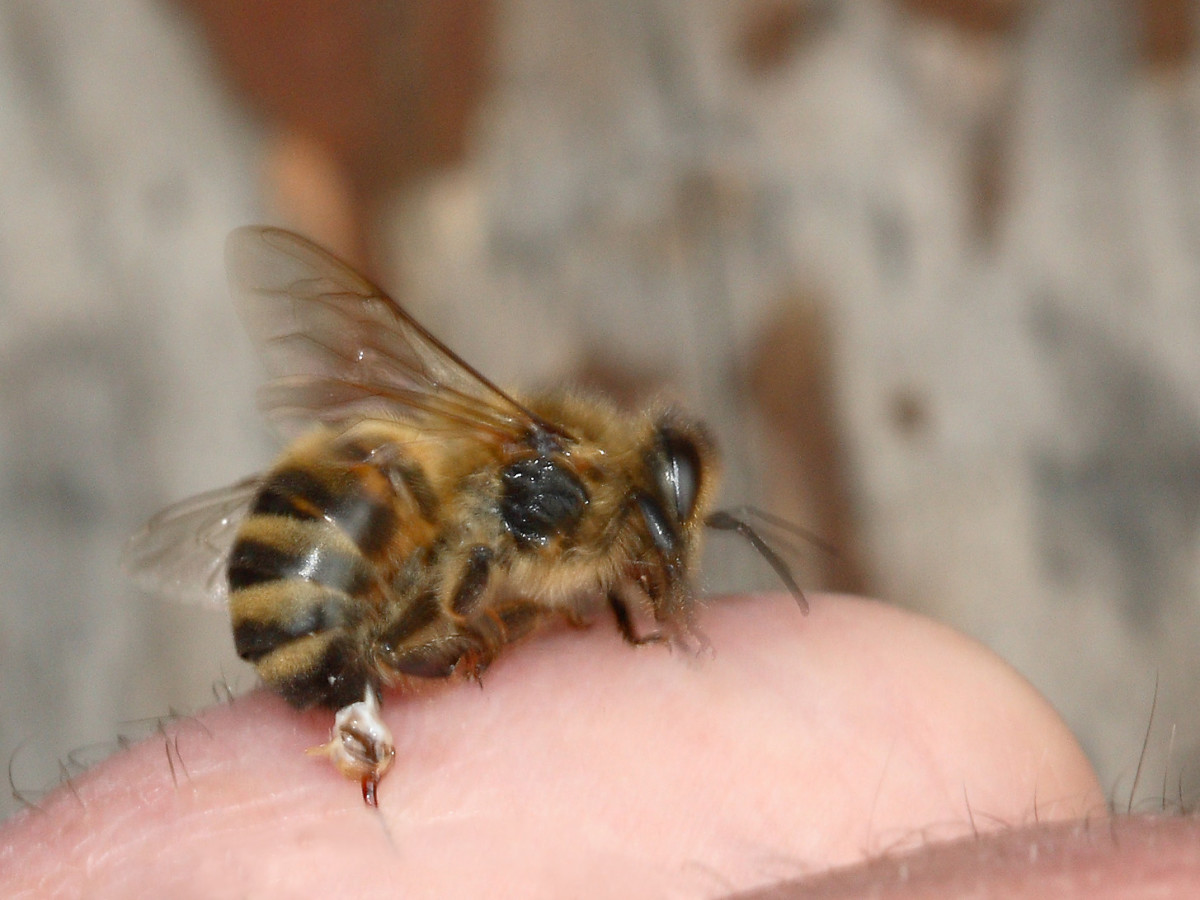
Yes, this is me 24 hours after a bee sting to my eyelid—AND this isn't an allergic reaction.
Normal Reaction or a Bee Sting Allergy?
If you are having any of the following symptoms, immediately call 911 or go to the hospital. You are having an allergic reaction to the bee sting if you are experiencing:
shortness of breath
a difficult time swallowing
swelling in the face, mouth, or throat
a break out of hives
increased heart rate
decrease in blood pressure
What to Do if a Bee Has Stung You in the Eye
Being stung by a bee can be a very scary occurrence; if you are stung in the eye it can be days before you are back to normal. Being a beekeeper, I expect to be stung; it's part of the job. I didn't, however, expect to be stung in the eye.
This article includes:
- Information on treatments—both home remedies as well as prescriptions.
- A photo progression chronicling the recovery of my facial swelling from hours after the sting up to six days when I was almost fully recovered.
- Types of reactions.
- Information on how long the itching and swelling will last.
- Prevention.
- Information on bee biology.
How to Treat a Non-Allergenic Bee Sting: Act Fast!
- After a bee stings, a stinger and sac of venom is left behind in your skin. To reduce the amount of venom in your body remove stinger and bag of venom as quickly as possible. You can SCRAPE the stinger and bag of venom out of your skin with a fingernail or other similar object. Do not pull out stinger or squeeze the location as more venom can be released. The longer that you leave in the stinger, the more venom will be left in your body causing swelling and itchiness.
- Once the stinger is removed, wash area with soap and water and apply antiseptic and soothing cream like hydrocortisone.
- If possible, and if over two years of age and not pregnant, immediately take an antihistamine, e.g., Benadryl, to reduce swelling and itching. (When I was stung on my finger, I had minimal swelling and itching because I took a Benadryl immediately. I did not take a Benadryl shortly after my facial sting because I didn't want to fall asleep. It was a big mistake.)
- Apply ice pack to site to reduce swelling and for pain relief.
- For additional pain relief, you can take an anti-inflammatory like ibuprofen.
Bee Sting Treatments
Over the Counter
|
Prescription
|
Home Remedies for Bee Stings (apply to site of sting)
|
|---|---|---|
Soap and water
|
Dexamethasone (Decadron) a corticosteroid to treat allergy. It decreases your body's natural defense response and reduces symptoms such as swelling and allergic-type reactions
|
Meat tenderizer and water paste
|
Antiseptic
|
Famotide (Pepcid) an H2 Histamine blocker.
|
Tobacco juice
|
Hydrocortisone Cream or Calamine Lotion
|
Hydroxyzine (Atarax) treats itching. Blocks natural substance (histamine) that your body makes during an allergic reaction. Causes drowsiness.
|
Vinegar
|
Ice Pack
|
Aloe
| |
Benadryl or other Antihistamine
|
Toothpaste
| |
Ibuprofen
|
Honey
| |
Baking soda and water paste
| ||
Chewed plantain leaf
| ||
Crushed basil or parsley leaves
|
These treatments are NOT for those that have severe allergic reactions. For severe allergic reactions, epinephrine will need to be injected to stop the progression of symptoms.
Severe allergic reactions can result in death within minutes of being stung. Having an Epi-Pen on hand if you are allergic to bees is a must. I had a reaction to the sting that was fairly severe, mainly due to the location of the sting on my eyelid. I, however, did NOT have an allergic reaction to the venom. It is very rare for someone to be allergic to bee venom, however, around 50 people a year die from a severe allergic reaction to a bee sting.
Medications I Took After Bee Sting
Day 1: Benadryl every 8 hours and ice.
Day 2: Benadryl in the morning. Was given prescription in the afternoon. Took 10mg of Dexamethasone (Decadron), one tablet of Hydroxyzine, and one tablet of Famotidine.
Day 3-6: Hydroxyzine and Famotidine until swelling and itching were gone as prescribed.
Three Types of Bee Sting Reactions and Symtoms
Normal
|
Localized
|
Allergic
|
|---|---|---|
Pain at site of sting
|
Pain around site of sting
|
MEDICAL ATTENTION IS NEEDED IMMEDIATELY
|
Swelling at site of sting
|
Swelling can extend beyond site of sting. If stung in eye, could radiate to bridge of nose, down cheek, and to other eye
|
Difficulty breathing and swallowing
|
Redness at site of sting
|
Redness around site of sting
|
Face, throat and mouth swelling
|
Increased heart rate
| ||
Hives (red and itchy spots) beyond site of sting
| ||
Drop in blood pressure
| ||
Dizziness
| ||
Restlessness or Anxiety
|
How Long Will the Swelling and Itchiness Last?
The amount of swelling from a bee sting depends on:
- The location of the sting (areas of the body that are more sensitive like the lip or eye swell significantly more)
- Whether or not you promptly removed the stinger
- Your treatment of the sting immediately after you were stung.
If you are stung on a sensitive part of your body like the eye or lip, it can take 5 to 7 days for the swelling to be completely gone. If you are stung on another part of your body (a hand, arm, leg, or foot) the swelling should go down in two to three days. However, in most cases you will have itchiness for up to a week.

Bee stinging and leaving behind stinger | Source
How to Prevent Bee Stings
Worker honey bees sting for one reason: to protect the hive or themselves. Honey bees are usually not offensive animals; they sting if they are threatened. Simply letting the bee be, is your best course of action. The bee will eventually fly away, and you will be left without a sting and the bee will be back to its business of collecting nectar and pollinating your flowers. However, if you swat, hit, or step on the bee, it will most likely sting you. It is a natural defense mechanism.
Bees are fascinating animals. The hive works as one large superorganism; each bee has a job. Their role in the hive is predetermined by their age and what is occurring in and out of the hive. The bees that sting are either guard bees or forager bees. Bees near a hive sting to protect their home. Away from the hive, most bees will not sting if they land on you.
Beekeepers wear protective clothing for this reason. Guard bees protect the hive from intruders, whether they are a skunk or a human. Most beekeepers are not stung when they go in the hive because they take precautions. The two best defenses against bee stings are your protective clothing and smoke.
How does Smoke Prevent Bee Stings?
For a beekeeper, having a good smoker is a must. Smoke does two main things: causes bees to consume honey rather than defend the hive and masks alarm pheromones. When a bee smells smoke it goes into survival mode. It is no longer protecting the hive because the hive is on fire. It instead gorges itself on honey to ensure its survival when it is time to fly out of the hive to safety. Smoke will also mask the alarm pheromone that bees emit when they are under attack. When a hive is "under attack" guard bees will raise their abdomen and release an alarm pheromone called isopentyl acetate. This pheromone is also released when a bee stings inciting other bees to follow suit to protect the hive. This alarm pheromone chemical is also found in bananas; this is why stings sometimes smell like bananas and a reason to never bring a banana near a hive or eat one before entering a hive.
Why do Bees Die after they Sting?
Honey bees, worker honey bees to be exact, have barbed stingers. When a bee stings, its stinger is left in your skin as the bee flies away. Unless removed, the barbs in the stinger ensure that the stinger stays in your skin to release venom for the next 30-45 seconds. When the bee flies away, the stinger is ripped from the bees abdomen causing irreparable damage, and the bee will die.
Queen honey bees do not have barbed stingers so they will not die after they sting. They rarely leave the hive unless to mate or swarm, so it is incredibly unlikely to be stung by one.
Drone Bees, Stingers, and Mating
A drone bee's (male bee) only purpose is to mate with a Queen. Since they do not defend the hive, they do not have stingers. Drones will leave their hive to inseminate queens in an area called a Drone Congregation Area. They will fly 200 to 300 feet above ground attempting to inseminate a queen. While drone bees do not have stingers, their sexual organ is barbed. If they are one of the "lucky" ones to mate, they quickly die after mating because their sexual organ is left inside the queen and ripped from their body. The next drone to inseminate the queen must remove the last drone's sexual organ to inseminate her further. Queens will mate up to 12 times in their one mating flight from their hive.
My Story of Being Stung
When I was stung, I had just gone into my hive wearing my beekeeping gear and hood. I was not stung while tending the hive and was fine. Unfortunately, while 10 feet away from my hive, I took off my hood and a bee landed on my eyelid. Had I left the bee alone I probably wouldn't have been stung. Unfortunately, I swiped away at my eye before I thought about what I was doing and was stung in the eyelid. While the sting itself didn't hurt very much, the next few days were a bit uncomfortable.
Searching online, I wanted to know what my next few days after being stung in the eye would be like. Would the swelling get worse or better in the next few days? Would both of my eyes close? Would there be pain and itching? When would I be back to normal? Since there wasn't any information, I thought I would chronicle what happened to my eye after I was stung and the mistakes that I made that impeded my recovery. I hope the information provided helped in your recovery!
Recovering from a Bee Sting
A week after the initial bee sting to the eye, I was completely recovered. While the site of the sting never hurt, it was unnerving not to have the use of one eye for a day, and my equilibrium was off. The closest thing that I can equate it to is claustrophobia. Not being able to open your eye is a troubling feeling. The balance issues could have been due to the medications, but I did not feel completely myself for about six days after the sting. Getting stung is never fun, but if you want to be a beekeeper, there are definite advantages: honey! If you have been stung, please leave your feedback below to help others that are experiencing the effects of a bee sting.
Source: http://hubpages.com/animals/Bee-Stings-on-the-Eye

No comments:
Post a Comment